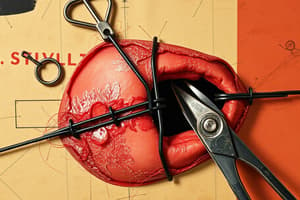Podcast
Questions and Answers
What is the primary function of sutures after a surgical procedure?
What is the primary function of sutures after a surgical procedure?
- To provide hemostasis by tamponading underlying bleeding tissue
- To approximate the opposing wound edges and hold the flap in position (correct)
- To cover exposed bone and prevent it from becoming nonvital
- To promote wound healing by secondary intention
Which statement regarding wound healing is correct?
Which statement regarding wound healing is correct?
- Minimal spacing between wound edges promotes rapid and complete healing (correct)
- Excessive trauma to wound margins has no effect on the healing process
- Sutures are not necessary for wound healing to occur
- Wound healing occurs faster by secondary intention than by primary intention
Which statement about sutures and hemostasis is true?
Which statement about sutures and hemostasis is true?
- Sutures can only aid in hemostasis through tamponade in an oozing area (correct)
- Overlying tissue should be sutured tightly to control bleeding in a tooth socket
- If underlying tissue is bleeding, the surface should be closed with sutures
- Sutures can provide complete hemostasis in a bleeding tooth socket
What is the importance of covering exposed bone with soft tissue?
What is the importance of covering exposed bone with soft tissue?
Which statement regarding wound irrigation and débridement is correct?
Which statement regarding wound irrigation and débridement is correct?
What is the recommended course of action if underlying tissue is bleeding?
What is the recommended course of action if underlying tissue is bleeding?
What is the main reason for using sutures when reflecting mucoperiosteal flaps from alveolar bone?
What is the main reason for using sutures when reflecting mucoperiosteal flaps from alveolar bone?
What type of suture is recommended to provide a barrier to clot displacement in the alveolar socket?
What type of suture is recommended to provide a barrier to clot displacement in the alveolar socket?
What is the primary role of suturing across an open wound socket in maintaining the blood clot?
What is the primary role of suturing across an open wound socket in maintaining the blood clot?
What is the recommended length and design of the needle holder for suturing in the mouth?
What is the recommended length and design of the needle holder for suturing in the mouth?
What is the most common shape of suture needle used for oral surgery?
What is the most common shape of suture needle used for oral surgery?
Where should sutures be placed when repositioning an envelope flap?
Where should sutures be placed when repositioning an envelope flap?
Flashcards are hidden until you start studying
Study Notes
Sutures and Wound Healing
- The primary function of sutures after a surgical procedure is to approximate and stabilize tissue, promote wound healing, and prevent complications.
Wound Healing
- Wound healing is a complex process that involves coagulation, inflammation, proliferation, and remodeling.
Sutures and Hemostasis
- Sutures can help achieve hemostasis by compressing the wound edges, reducing bleeding, and promoting platelet aggregation.
Exposed Bone and Soft Tissue
- Covering exposed bone with soft tissue is important to prevent bone desiccation, promote bone healing, and reduce the risk of infection and complications.
Wound Irrigation and Débridement
- Wound irrigation and débridement are essential for removing debris, bacteria, and dead tissue, promoting wound healing, and preventing infection.
Bleeding and Underlying Tissue
- If underlying tissue is bleeding, the recommended course of action is to apply gentle pressure, use hemostatic agents, and suture the wound to achieve hemostasis.
Suturing and Mucoperiosteal Flaps
- The main reason for using sutures when reflecting mucoperiosteal flaps from alveolar bone is to minimize bleeding, promote tissue stability, and facilitate wound healing.
Suture Type and Alveolar Socket
- A resorbable suture is recommended to provide a barrier to clot displacement in the alveolar socket.
Suturing and Blood Clot
- The primary role of suturing across an open wound socket is to maintain the blood clot, promote wound healing, and prevent complications.
Needle Holder and Suturing
- The recommended length and design of the needle holder for suturing in the mouth is 10-12 cm, with a curved or angled tip, allowing for precise control and manipulation.
Suture Needle Shape
- The most common shape of suture needle used for oral surgery is the reverse-cutting needle, which is designed to minimize tissue trauma and promote smooth passage through tissue.
Suture Placement and Envelope Flap
- Sutures should be placed at the apex of the flap, 2-3 mm from the edge, when repositioning an envelope flap, to ensure secure tissue approximation and minimize tissue trauma.
Studying That Suits You
Use AI to generate personalized quizzes and flashcards to suit your learning preferences.




